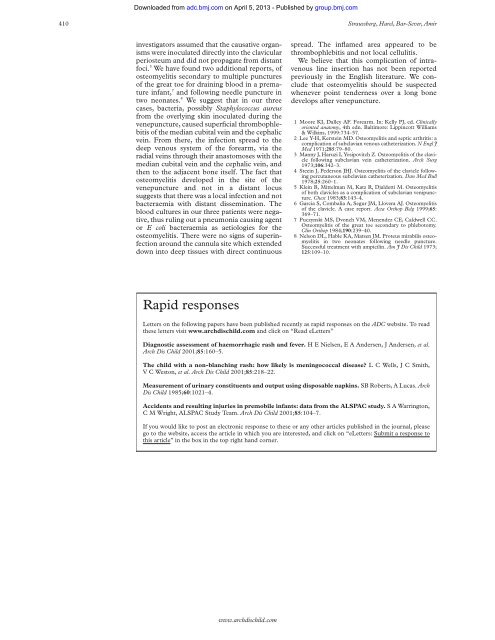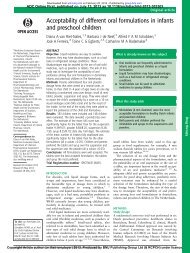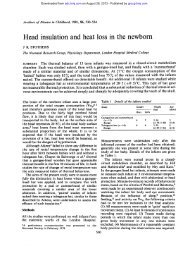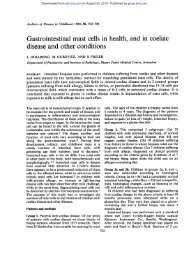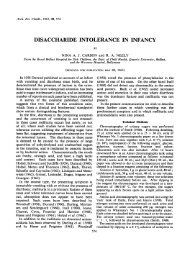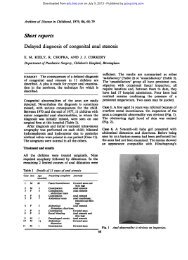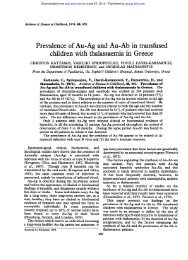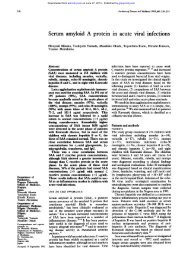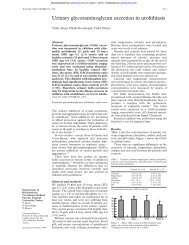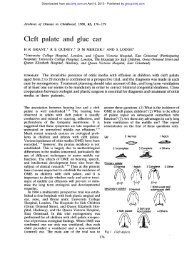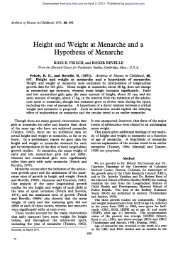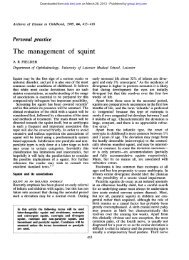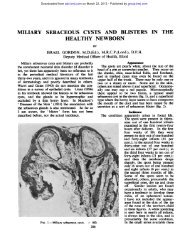Radial osteomyelitis as a complication of venous cannulation
Radial osteomyelitis as a complication of venous cannulation
Radial osteomyelitis as a complication of venous cannulation
Create successful ePaper yourself
Turn your PDF publications into a flip-book with our unique Google optimized e-Paper software.
Downloaded from<br />
adc.bmj.com on April 5, 2013 - Published by group.bmj.com<br />
410 Straussberg, Harel, Bar-Sever, Amir<br />
investigators <strong>as</strong>sumed that the causative organisms<br />
were inoculated directly into the clavicular<br />
periosteum and did not propagate from distant<br />
foci. 5 We have found two additional reports, <strong>of</strong><br />
<strong>osteomyelitis</strong> secondary to multiple punctures<br />
<strong>of</strong> the great toe for draining blood in a premature<br />
infant, 7 and following needle puncture in<br />
two neonates. 8 We suggest that in our three<br />
c<strong>as</strong>es, bacteria, possibly Staphylococcus aureus<br />
from the overlying skin inoculated during the<br />
venepuncture, caused superficial thrombophlebitis<br />
<strong>of</strong> the median cubital vein and the cephalic<br />
vein. From there, the infection spread to the<br />
deep <strong>venous</strong> system <strong>of</strong> the forearm, via the<br />
radial veins through their an<strong>as</strong>tomoses with the<br />
median cubital vein and the cephalic vein, and<br />
then to the adjacent bone itself. The fact that<br />
<strong>osteomyelitis</strong> developed in the site <strong>of</strong> the<br />
venepuncture and not in a distant locus<br />
suggests that there w<strong>as</strong> a local infection and not<br />
bacteraemia with distant dissemination. The<br />
blood cultures in our three patients were negative,<br />
thus ruling out a pneumonia causing agent<br />
or E coli bacteraemia <strong>as</strong> aetiologies for the<br />
<strong>osteomyelitis</strong>. There were no signs <strong>of</strong> superinfection<br />
around the cannula site which extended<br />
down into deep tissues with direct continuous<br />
Rapid responses<br />
spread. The inflamed area appeared to be<br />
thrombophlebitis and not local cellulitis.<br />
We believe that this <strong>complication</strong> <strong>of</strong> intra<strong>venous</strong><br />
line insertion h<strong>as</strong> not been reported<br />
previously in the English literature. We conclude<br />
that <strong>osteomyelitis</strong> should be suspected<br />
whenever point tenderness over a long bone<br />
develops after venepuncture.<br />
1 Moore KI, Dalley AF. Forearm. In: Kelly PJ, ed. Clinically<br />
oriented anatomy, 4th edn. Baltimore: Lippincott Williams<br />
& Wilkins, 1999:734–57.<br />
2 Lee Y-H, Kerstein MD. Osteomyelitis and septic arthritis: a<br />
<strong>complication</strong> <strong>of</strong> subclavian <strong>venous</strong> catheterization. N Engl J<br />
Med 1971;285:79–80.<br />
3 Manny J, Haruzi I, Yosipovitch Z. Osteomyelitis <strong>of</strong> the clavicle<br />
following subclavian vein catheterization. Arch Surg<br />
1973;106:342–3.<br />
4 Steein J, Pederson JHJ. Osteomyelitis <strong>of</strong> the clavicle following<br />
percutaneous subclavian catheterization. Dan Med Bull<br />
1978;25:260–1.<br />
5 Klein B, Mittelman M, Katz R, Djaldetti M. Osteomyelitis<br />
<strong>of</strong> both clavicles <strong>as</strong> a <strong>complication</strong> <strong>of</strong> subclavian venipuncture.<br />
Chest 1983;83:143–4.<br />
6 Garcia S, Combalia A, Segur JM, Llovera AJ. Osteomyelitis<br />
<strong>of</strong> the clavicle. A c<strong>as</strong>e report. Acta Orthop Belg 1999;65:<br />
369–71.<br />
7 Puczynski MS, Dvonch VM, Menendez CE, Caldwell CC.<br />
Osteomyelitis <strong>of</strong> the great toe secondary to phlebotomy.<br />
Clin Orthop 1984;190:239–40.<br />
8 Nelson DL, Hable KA, Matsen JM. Proteus mirabilis <strong>osteomyelitis</strong><br />
in two neonates following needle puncture.<br />
Successful treatment with ampicilin. Am J Dis Child 1973;<br />
125:109–10.<br />
Letters on the following papers have been published recently <strong>as</strong> rapid responses on the ADC website. To read<br />
these letters visit www.archdischild.com and click on “Read eLetters”<br />
Diagnostic <strong>as</strong>sessment <strong>of</strong> haemorrhagic r<strong>as</strong>h and fever. H E Nielsen, E A Andersen, J Andersen, et al.<br />
Arch Dis Child 2001;85:160–5.<br />
The child with a non-blanching r<strong>as</strong>h: how likely is meningococcal dise<strong>as</strong>e? L C Wells, J C Smith,<br />
V C Weston, et al. Arch Dis Child 2001;85:218–22.<br />
Me<strong>as</strong>urement <strong>of</strong> urinary constituents and output using disposable napkins. SB Roberts, A Luc<strong>as</strong>. Arch<br />
Dis Child 1985;60:1021–4.<br />
Accidents and resulting injuries in premobile infants: data from the ALSPAC study. S A Warrington,<br />
C M Wright, ALSPAC Study Team. Arch Dis Child 2001;85:104–7.<br />
If you would like to post an electronic response to these or any other articles published in the journal, ple<strong>as</strong>e<br />
go to the website, access the article in which you are interested, and click on “eLetters: Submit a response to<br />
this article” in the box in the top right hand corner.<br />
www.archdischild.com


